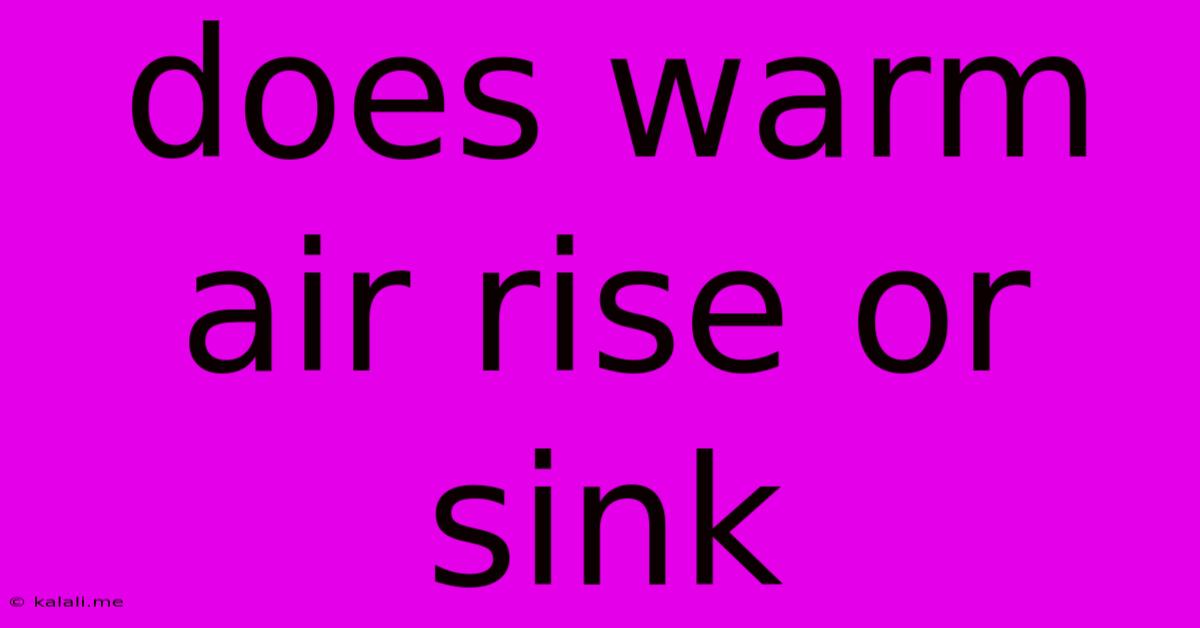Does Warm Air Rise Or Sink
Kalali
Jun 02, 2025 · 3 min read

Table of Contents
Does Warm Air Rise or Sink? Understanding Convection Currents
Have you ever wondered why hot air balloons float? Or why smoke rises from a chimney? The answer lies in the fundamental principle of convection, and understanding whether warm air rises or sinks is key to grasping this concept. This article will delve into the science behind it, exploring density, buoyancy, and the resulting air movements.
The Simple Answer: Warm air rises. This is because warm air is less dense than cold air. Let's break down why.
Density and Buoyancy: The Key Players
-
Density: Density refers to how much mass is packed into a given volume. Think of it like this: a kilogram of feathers takes up much more space than a kilogram of lead. The feathers are less dense. Similarly, when air is heated, its molecules become more energetic and move farther apart, resulting in lower density.
-
Buoyancy: Buoyancy is the upward force exerted on an object submerged in a fluid (like air or water). An object will float if its buoyant force is greater than its weight. Because warm air is less dense than cold air, it experiences a greater buoyant force, causing it to rise.
How Warm Air Rising Creates Convection Currents
The rising of warm air initiates a process called convection. This is a crucial mechanism for heat transfer in the atmosphere and many other systems. Here’s how it works:
- Heating: A source of heat (like the sun, a radiator, or a fire) warms the air in contact with it.
- Expansion and Rising: The warmed air expands, becoming less dense and rising.
- Cooling: As the warm air rises, it encounters cooler air, causing it to cool and become denser.
- Sinking: The now cooler, denser air sinks, creating a cycle.
- Continuous Circulation: This cycle of rising warm air and sinking cool air creates a continuous circulation pattern known as a convection current.
Exceptions and Complicating Factors
While the general rule is that warm air rises, there are some factors that can influence this:
-
Humidity: Moist air is slightly less dense than dry air at the same temperature. This is because water vapor molecules are lighter than nitrogen and oxygen molecules. Therefore, humid warm air might rise even more readily than dry warm air.
-
Wind: Strong winds can disrupt convection currents, pushing warm air horizontally instead of allowing it to rise vertically.
-
Pressure: Changes in atmospheric pressure can also affect the movement of air masses. High-pressure systems generally have sinking air, while low-pressure systems have rising air.
Real-World Examples of Convection Currents
Understanding convection currents helps us explain many everyday phenomena:
- Weather patterns: Large-scale convection currents drive weather systems, creating clouds, rain, and wind.
- Ocean currents: Similar processes occur in oceans, where warm water rises and cool water sinks, creating ocean currents that distribute heat around the globe.
- Heating and cooling systems: Many heating and cooling systems utilize convection currents to distribute air efficiently.
In conclusion, while there are exceptions, the general principle remains true: warm air rises because it is less dense than cold air. This simple yet powerful concept drives many important processes in the natural world and is essential to understanding meteorology, oceanography, and even the operation of various technologies.
Latest Posts
Latest Posts
-
What Temperature Does Yeast Die At
Jun 04, 2025
-
Can You Stay Dead For Rewaqrds World Bosses
Jun 04, 2025
-
Did L Know Light Was Kira
Jun 04, 2025
-
How Do Hummingbirds Find A Feeder
Jun 04, 2025
-
How Do Real Estate Commissions Off Rental Property
Jun 04, 2025
Related Post
Thank you for visiting our website which covers about Does Warm Air Rise Or Sink . We hope the information provided has been useful to you. Feel free to contact us if you have any questions or need further assistance. See you next time and don't miss to bookmark.